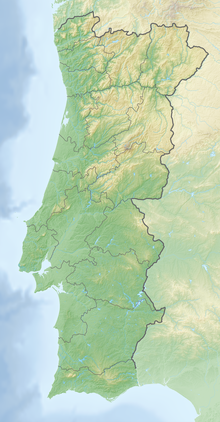Anta do Alcogulo II
Location of the Anta do Alcogulo II in Portugal. |
The Anta do Alcogulo II , also called Anta 2 do Alcogulo , is a megalithic complex about 3.6 km west of Castelo de Vide, in the municipality ( Portuguese Freguesia ) São João Baptista in the district ( Portuguese Concelho ) Castelo de Vide , Portalegre district in the northeast Alentejo .
Anta , Mámoa , Dolmen , Orca and Lapa are the common names in Portugal for the approximately 5000 megalithic structures that were built during the Neolithic in the west of the Iberian Peninsula by the successors of the Cardial or Imprint culture .
Monument preservation
From 1867–1868 the complex was examined and published by Pereira da Costa and in 1997 it was registered and protected as Imóvel de Interest Público . A modern archaeological follow-up investigation of the site is still pending.
Although - apart from cleaning work in 2012 - no extensive security measures have been carried out so far, the Anta is one of the better preserved megalithic sites in the region. It is privately owned and can only be viewed with the permission of the owner.
Finding
The polygonal burial chamber is formed by seven granite bearing stones ( orthostats ) . All irregularly square bearing stones are still present in situ , but have inclined into the interior of the approximately 1.5 meter high chamber due to the fact that the cap stone has not been preserved.
Of the approximately 6-meter-long corridor , three lateral bearing stones on the north side and two on the south side and a capstone directly on the chamber have been preserved in situ.
The former hilltop ( Mámoa ) of the grave was badly damaged in the course of the construction work on the directly adjacent railway line, but is still largely recognizable.
The Anta do Alcogulo II belongs with the two neighboring Antas da Coutada de Alcogulo and Anta do Alcogulo III to a group of megalithic tombs that are spread over a radius of about 700 m. To what extent this is a grave field with recent or consecutive occupancy or whether the concentration in this richly found region was more “accidental”, must remain open due to the very rough dating of the three Antas.
Another cluster of five neighboring megalithic tombs - the Necrópole Megalítica de Coureleiros - was excavated just 1.5 km to the south.
Finds
No information is available about possible finds from the excavation between 1867 and 1868.
The dating of the complex can therefore only generally be in the period from the 4th to the 2nd millennium BC. Take place.
Individual evidence
- ↑ a b c d Domingos Bucho: Anta do Alcogulo II . Direção – Geral do Património Cultural - Sistema de Informação para o Património Arquitectónico, 1998, accessed on July 11, 2018 (Portuguese).
- ↑ Francisco A. Pereira da Costa: Noções sobre o estado préhistórico da terra e do homem seguidas da descripção de alguns dolmins ou antas de Portugal . Lisbon 1868, p. 90 (Portuguese).
- ↑ Decree n.º 67/97 (= Ministério da Cultura [Ed.]: Diário da República, Series-B . Band I , n.º 301). December 31, 1997, p. 6896 (Portuguese, dre.pt [PDF; accessed July 11, 2018]).
- ↑ a b c d Anta do Alcogulo II / Anta 2 do Alcogulo . Direção – Geral do Património Cultural - Portal do Arqueólogo, accessed on July 11, 2018 (Portuguese).
- ↑ a b c A. Martins: Anta do Alcogulo II . Direção – Geral do Património Cultural, accessed on July 11, 2018 (Portuguese).
literature
- A. Martins: Anta do Alcogulo II . Direção-Geral do Património Cultural, accessed on July 11, 2018 (Portuguese, with extensive literature sv Bibliografia).
Coordinates: 39 ° 24 '48 " N , 7 ° 31' 50.5" W.
